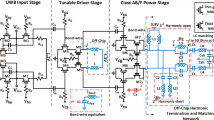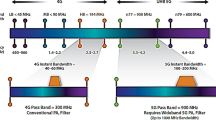Abstract
This paper presents a high-efficiency Class \({\mathrm{FF}}^{-1}\) DPA using the quad-mode coupled technique for new configurable front-end 5G transmitters. The proposed DPA consists of carrier PA, main PA, input–output matching network and hybrid power network (HPN). The HPN includes a quad-mode coupled technique which is four-section U-shaped transmission line. The HPN is used for even–odd mode impedance analysis to ensures the high-selectivity of output power and achieve a wideband response in the presence of harmonic control conditions. The optimum harmonic impedance is analyzed for the desired band to achieve high output power and efficiency. The DPA circuit is fabricated by using 0.25 µm GaN HEMT on silicon nitride monolithic microwave integrated circuit die process. At maximum output power level of 44.3 dBm, the delivered power-added efficiency (PAE) of 64.3–67.3% and drain efficiency (DE) of 71.7–73.7% at even–odd mode operation are achieved with a gain of 13.0–14.3 dB. For the output power level of 39.045 dBm corresponding to 9 dB output back-off (OBO), the drain efficiency lies between 55–62% with 73% fractional bandwidth. All the demonstrated transmission parameters are working in the band of 8–12 GHz. The size of the chip is 2.8 × 1.9 mm2 and it occupies less die area as compared to the existing DPAs.




















Similar content being viewed by others
References
Moon, J., & Woo Kim, Y.Y. (2009). A highly efficient doherty power amplifier employing optimized carrier cell. In IEEE Microwave Conference, pp. 1–4.
Kang, D., et al. (2011). Design of bandwidth—Enhance Doherty power amplifier for handset application. IEEE Transactions on Microwave Theory and Technology, 59(5), 3474–3484. https://doi.org/10.1109/TMTT.2011.2171042
Darraji, M., & Ghannouchi, F. M. (2011). Digital Doherty amplifier with enhanced efficiency and extended range. IEEE Transactions on Microwave Theory and Technnol, 59(8), 2898–2909. https://doi.org/10.1109/TMTT.2011.2166122
Lin, J., Zhang, K. et al. (2016). A linearity enhanced broadband Class-F power amplifier with high harmonic suppressed matching circuits for S-band applications. In Proceedings of the Microwave and Millimeter Wave Technology (ICMMT) International Conference, pp. 270–273.
Tango, Linl, X. et al. (2015). A new dual-band Wilkinson power divider. In: IEEE International Wireless Symposium, pp. 372–376.
Grebennikov, A. (2011). Load network design technique for class F and inverse class F PAs. Electronics Letters, 28(8), 58–76.
Son, J., Park, Y., et al. (2014). Broadband saturated power amplifier with harmonic control circuits. IEEE Microwave and Wireless Components Letters, 24(3), 185187. https://doi.org/10.1109/LMWC.2013.2292925
Miwa, S., Kamo, S., Kittaka, Y. et al. (2011). A 67% PAE, 100 W GAN power amplifiers with on-chip harmonic tuning circuits for C-band space applications. In IEEE MTT-S Int. Microwave Symp. Digest, Baltimore, MD, USA, pp. 1–4.
Dong, L. ,He, S., You, F., & Lei, Q. (2012). High-efficiency Class-F- 1 power amplifier design with input harmonic manipulation. In IEEE Topical Conference on Power Amplifiers for Wireless and Radio Applications, PAWR, pp. 1–4.
Tuffy, N., Guan, L., Zhu, A., & Brazil, T. J. (2013). A simplified broadband design methodology for linearized high-efficiency continuous Class-F power amplifiers. IEEE Transactions on Microwave Theory and Techniques, 60(6), 1952–1963. https://doi.org/10.1109/TMTT.2012.2187534
Hayat, A., & Grebennikov, A. (2015). Class-F power amplifier with high power added efficiency using bowtie shaped harmonic control circuit. IEEE Microwave and Wireless Components Letters, 5(2), 133–135. https://doi.org/10.1109/LMWC.2014.2382649
Sharma, T., Darraji, R., & Ghannouchi, M. (2016). Design methodology of high-efficiency contiguous mode harmonically tuned power amplifiers. In Proceedings of the IEEE Radio and Wireless Symposium, USA, pp. 149–150.
Kim, J., Jo, H. G. D., Oh, J. H., Kim, Y. H., Lee, K. C., & Jung, J. H. (2011). Modeling and design methodology of high-efficiency Class-F and inverse Class-F power amplifiers. IEEE Transactions on Microwave Theory and Techniques, 59(1), 153–165. https://doi.org/10.1109/TMTT.2010.2090167
Inoue, F., Heiman, A., et al. (2000). Analysis of Class-F and inverse Class-F amplifiers. In IEEE MTT-S International Microwave Symposium Digest, pp. 775–778.
Inoue, A., Ohta, A., Goto, S., & Ishikawa, T. (2004). The efficiency of Class-F and inverse Class-F amplifiers. In IEEE MTT-S International Microwave Symposium Digest, pp. 1947–1950.
Wood, Y., & Yang, J. (2006). Analysis and experiments for high efficiency Class-F and inverse Class-F power amplifiers. IEEE Transactions on Microwave Theory and Techniques, 54(5), 1969–1974. https://doi.org/10.1109/TMTT.2006.872805
Sheikh, A., Roff, C., et al. (2009). Peak Class F and inverse Class F drain efficiencies using Si LDMOS in a limited bandwidth design. IEEE Microwave and Wireless Component Letters, 19(7), 473–475. https://doi.org/10.1109/LMWC.2009.2022138
Wei. C. J., & Carlo. P. D. (2000). Analysis and experimental waveform study on inverse Class Class-F mode of microwave power FETs. In IEEE MTT-S International Microwave Symposium Digest, pp. 525–528.
Goto, S., Kunii, T. et al. (2014) Effect of bias condition and input harmonic termination on high efficiency inverse Class-F amplifiers. In Proceedings 31th European Microwave Conference, pp. 1–4.
Colantonio, P., & Giannini, F. (2010). High efficiency low-voltage power amplifier design by second-harmonic manipulation. International Journal of RF and Microwave Computer-Aided Engineering, 10(1), 19–32.
Cipriani, E., Colantonio, P., Giannini, F., & Giofrè, R. (2009). Theory and experimental results of AB-C Doherty power amplifier. IEEE Transactions on Microwave Theory and Techniques, 57(8), 1936–2194. https://doi.org/10.1109/TMTT.2009.2025433
Rubio, J. M., Fang, J., Camarchia, V., Quaglia, R., Pirola, M., & Ghione, G. (2012). 3–3.6-GHz wideband GaN Doherty power amplifier exploiting output compensation stages. IEEE Transactions on Microwave Theory and Techniques, 60(8), 2543–254. https://doi.org/10.1109/TMTT.2018.2867426
Nghiem, X. A., Guan, J., & Negra, R. (2015). Broadband sequential power amplifier with Doherty-type active load modulation. IEEE Transactions on Microwave Theory and Techniques, 63(9), 2821–2832.
Barakat, A., Thian, M., Fusco, V., Bulja, S., & Guan, L. (2017). Toward a more generalized Doherty power amplifier design for broadband operation. IEEE Transactions on Microwave Theory and Techniques, 65(3), 846–859. https://doi.org/10.1109/TMTT.2016.2633261
Gustafson, D., & Cahuana, J. C. (2013). A wideband and compact GaN MMIC Doherty amplifier for microwave link applications. IEEE Transactions on Microwave Theory and Techniques, 61(8), 922–930. https://doi.org/10.1109/TMTT.2012.2231421
Paul, S., Hou, R., Hellberg, R., & Berglund, B. (2018). A 1.8–3.8-GHz power amplifier with 40% efficiency at 8-dB power back-off. IEEE Transactions on Microwave Theory and Techniques, 58(11), 2741–2750. https://doi.org/10.1109/TMTT.2010.2077951
Kim, J. H., Jo, G. D., Oh, J. H., Kim, Y. H., Lee, K. C., & Jung, J. H. (2011). Modeling and design methodology of high-efficiency Class-F and Class-F power amplifiers. IEEE Transactions on Microwave Theory and Techniques, 59(1), 153–165. https://doi.org/10.1109/TMTT.2010.2090167
Kim, J. (2018). Highly efficient asymmetric class-F−1/F GaN Doherty amplifier. IEEE Transactions on Microwave Theory and Techniques, 59(1), 1350–1358. https://doi.org/10.1109/TMTT.2018.2839195
Kuroda, K., & Ishikawa, R. (2010). Parasitic compensation design technique for a C-band GaN HEMT Class-F amplifier. IEEE Transactions on Microwave Theory and Techniques, 58(11), 2741–2750. https://doi.org/10.1109/TMTT.2010.2077951
Gustafson, D., & Cahuana, C. (2014). A GaN MMIC modified Doherty PA with large bandwidth and reconfigurable efficiency. IEEE Transactions on Microwave Theory and Techniques, 62(4), 3006–3016. https://doi.org/10.1109/TMTT.2014.2362136
Giofrè, R., & Colantonio, P. (2017). A high efficiency and low distortion 6 W GaN MMIC Doherty amplifier for 7 GHz radio links. IEEE Microwave Wireless Components Letters, 27(1), 70–72. https://doi.org/10.1109/LMWC.2016.2629972
Yang, Z., Yao, Y., Li, M., Jin, Y., Li, T., Dai, Z., et al. (2019). Bandwidth extension of Doherty power amplifier using complex combining load with noninfinity peaking impedance. IEEE Transactions on Microwave Theory Techniques, 67(2), 765–77. https://doi.org/10.1109/TMTT.2018.2884415
Zhou, X., Chan, W., Zheng, S., Feng, W., Liu, H., Cheng, K., et al. (2019). A mixed topology for broadband high-efficiency Doherty power amplifier. IEEE Transactions on Microwave Theory and Techniques, 67(3), 1050–64. https://doi.org/10.1109/TMTT.2019.2893178
Kim, J. (2019). Analysis and design optimisation for inverse Class-F GaN Doherty amplifier. IET Microwaves, Antennas and Propagation, 13(4), 448–454. https://doi.org/10.1049/iet-map.2018.5124
Naah, G., & He, W. (2020). Symmetrical Doherty power amplifier design via continuous harmonic-tuned Class-J mode. International Journal of Electron and Communications, 106, 96–102. https://doi.org/10.1016/j.aeue.2019.05.008
Gan, D., Shi, W., et al. (2020). Design of continuous mode Doherty power amplifiers using generalized output combiner. International Journal of Electronics and Communications, 116, 1–9. https://doi.org/10.1016/j.aeue.2020.153069
Colantonio, P., Giannini, F., et al. (2020). Compact harmonic control network for Doherty power amplifier. Microwave and Optical Technology Letters, 51(1), 256–258. https://doi.org/10.1002/mop.23983
Giofrè, R., Piazzon, L., Colantonio, P., & Giannin, F. (2014). An ultra-broadband GaN Doherty amplifier with 83% of fractional bandwidth. IEEE Microwave and Wireless Components Letters, 24(11), 775–777. https://doi.org/10.1109/lmwc.2014.2345193
Acknowledgment
This research was supported by the Basic Science Research Program through the National Research Foundation of Korea (NRF) funded by the Ministry of Education, Science and Technology (NRF-2019R1F1A1056937). This research was also supported by the KOREA- INDIA joint program of cooperation in science & technology through the National Research Foundation of Korea (NRF) funded by the Ministry of Education, Science and Technology (NRF-2020K1A3A1A19086889).
Author information
Authors and Affiliations
Corresponding author
Additional information
Publisher's Note
Springer Nature remains neutral with regard to jurisdictional claims in published maps and institutional affiliations.
Appendix
Appendix
\(Z_{1} = \sqrt {Z_{1e} z_{10} }\),\( Z_{2} = \sqrt {Z_{2e} z_{20} }\), \(Z_{3} = \sqrt {Z_{3e} z_{30} }\) and \(Z_{4} = \sqrt {Z_{4e} z_{40} }\)
Rights and permissions
About this article
Cite this article
Kumar, R., Dwari, S., Kanaujia, B.K. et al. A 8–12 GHz, 44.3 dBm RF output class FF−1 DPA using quad-mode coupled technique for new configurable front-end 5G transmitters. Analog Integr Circ Sig Process 107, 497–510 (2021). https://doi.org/10.1007/s10470-021-01823-0
Received:
Revised:
Accepted:
Published:
Issue Date:
DOI: https://doi.org/10.1007/s10470-021-01823-0




